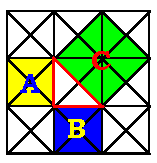Area and Boundary Length (Perimeter)
Area Measurement and Number
 The image visually presents the idea of related squares
by colored triangles. The author1 continues:
The image visually presents the idea of related squares
by colored triangles. The author1 continues:
Count the triangles within the squares. The number of green triangles equals
the total of those that are yellow and blue!1
The above is an animated special case. It introduces us to an observation
known to artisans, and enshrined in mathematics. The fundamental there
is a corner formed by two lines that meet at a special angle called
right. The meaning of the term is simply that four successive
right angle movements return one to the same place.
Mathematics as an abstract subject began with Greek efforts (though the
underlying ideas lived, and continue) in other cultures. The book that
changed things from general notions known to practical workers into a
body of concepts was Euclid's. The general issue of the animation
appears in Euclid's Elements, Book I, Proposition 47; see e.g., the translation, guide2.
A square has area given by multiplying the two (same) numbers associated
with adjacent sides. The process also works for a figure that has four right
angles but different side lengths. Such a figure, called a
rectangle, can be divided into two three-sided parts by a diagonal:
each one is a triangle. Since each part makes up half the rectangle,
a triangle's area is half the height times base length.
Two questions are related to how we number shape properties:
1. What are the valid numbers for side lengths of such
shapes?
2. For such lengths, what results for the area (kind of number)?
The first question could limit answers to ratios of integers or
rational numbers, and lead to a second requirement that the area
be a counting (whole, natural) number [1, pp. 190-193]. Problems of
Number.
Acknowledgements and References
1Dorene Lau is responsible for the animation; it was included in a report where she
wrote these words.
2David E. Joyce, Department of Mathematics and Computer Science ,
Clark University, 950 Main Street, Worcester, MA 01610, translated
Euclid's works and created the guide to related material from other
cultures.
[1] Devlin, K. The Millennium Problems, NY: Basic Books, 2002.
[2] Lönnemo, H. Andres, The
Trinary Tree(s) underlying Primitive Pythagorean Triples
|
4/06/03 Version |
|
|
http://www.cs.ucla.edu/~klinger/nmath/pyth.html |
|
©2003 Allen Klinger
|

